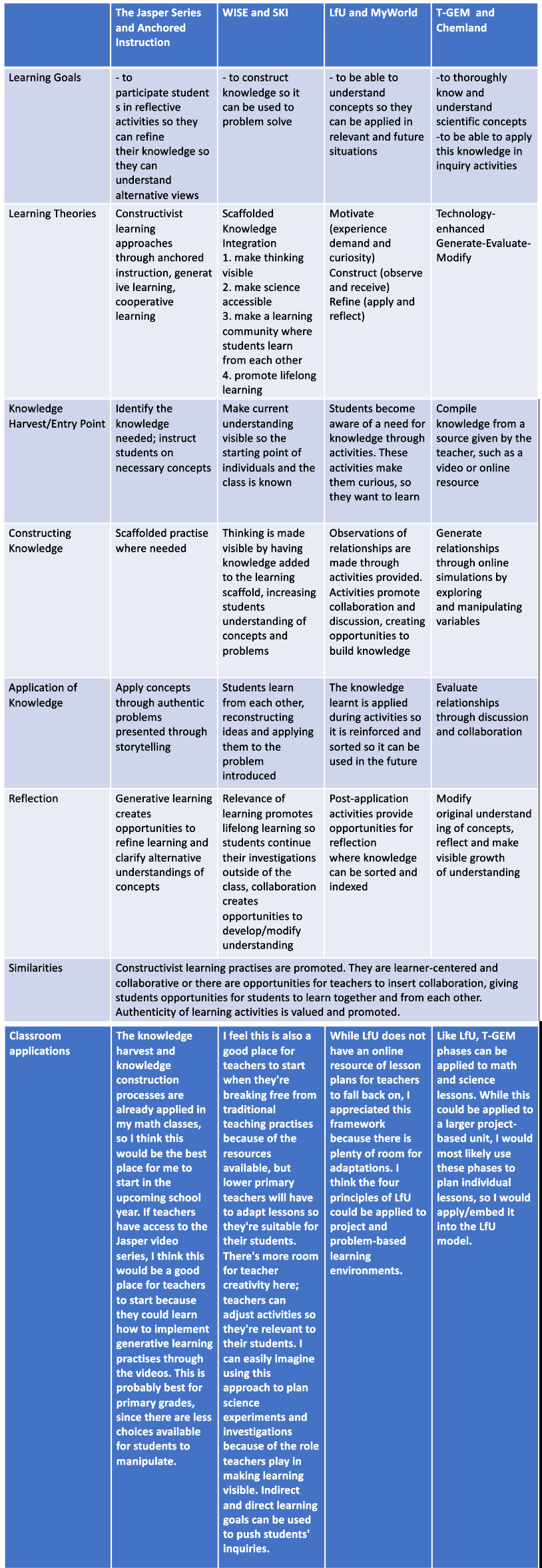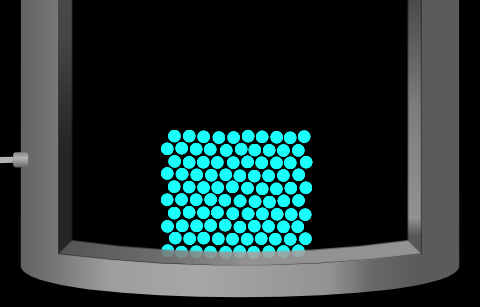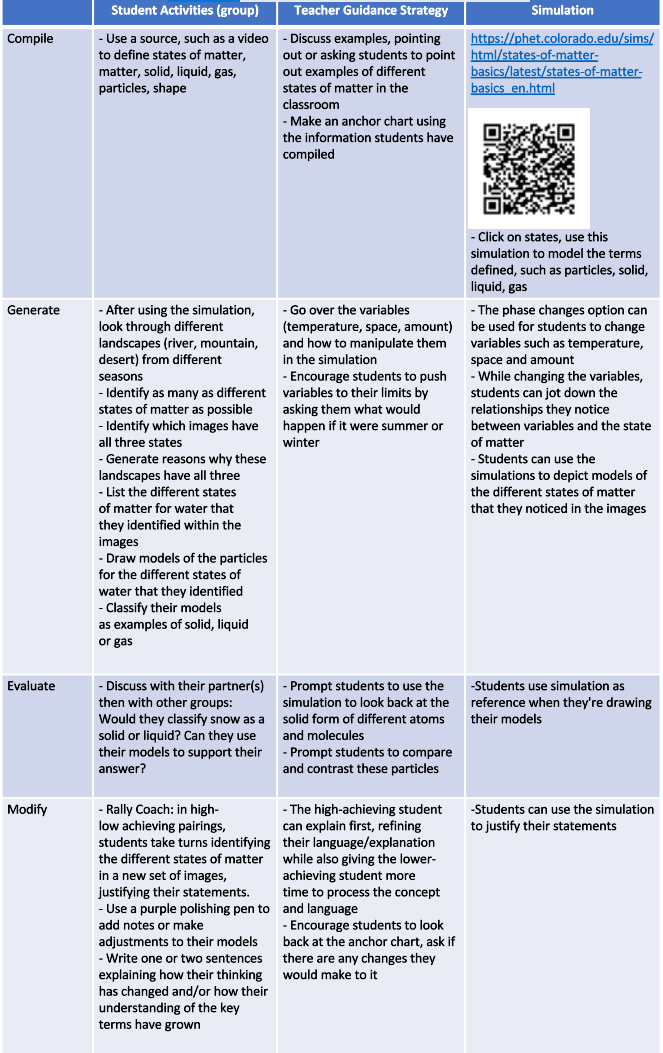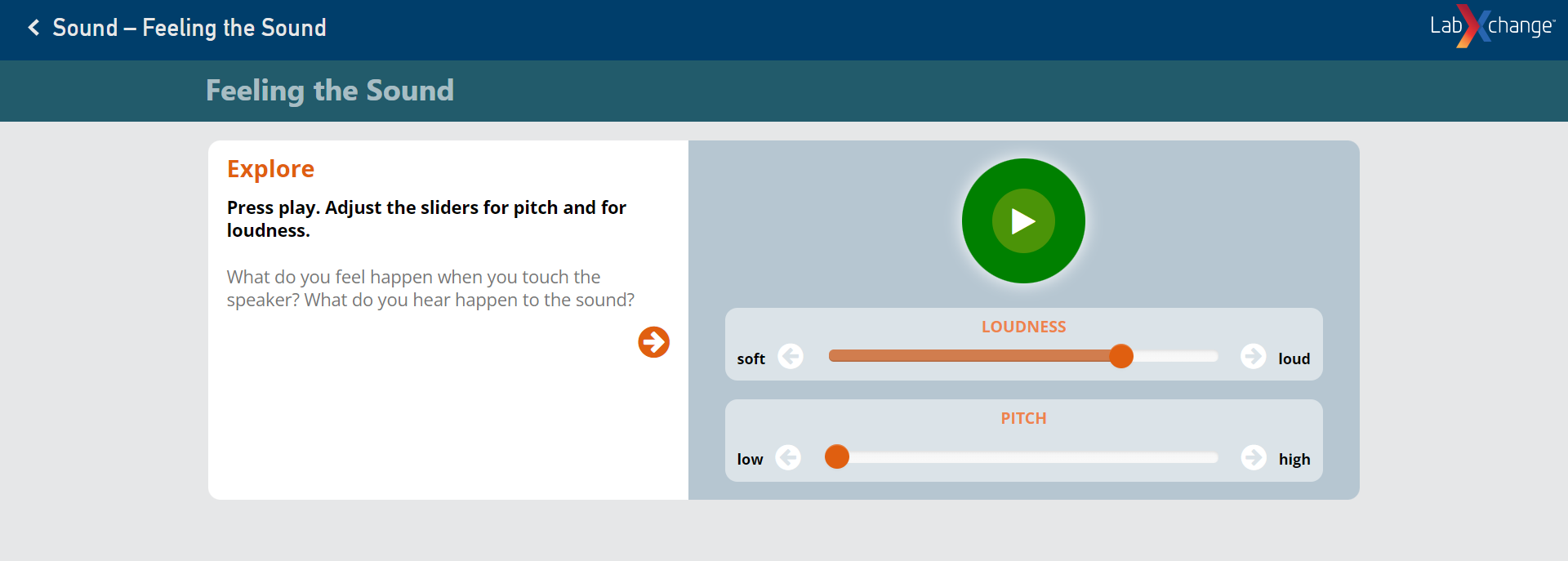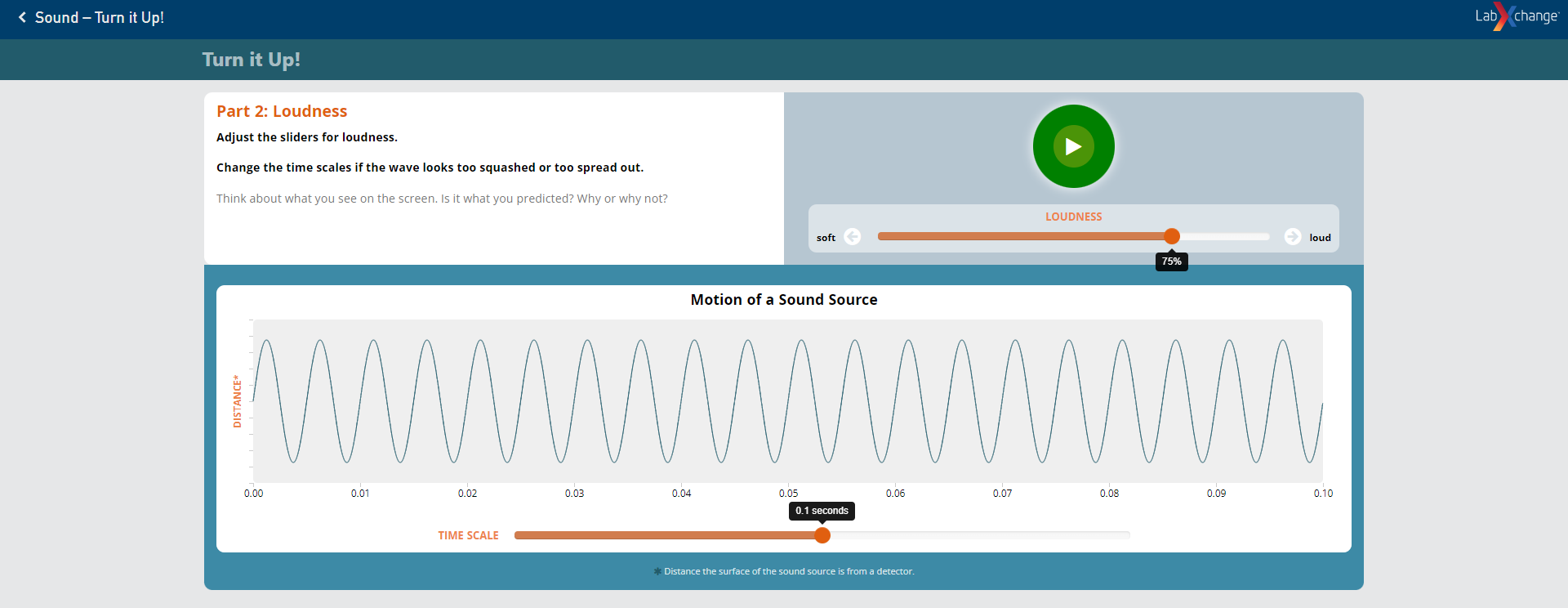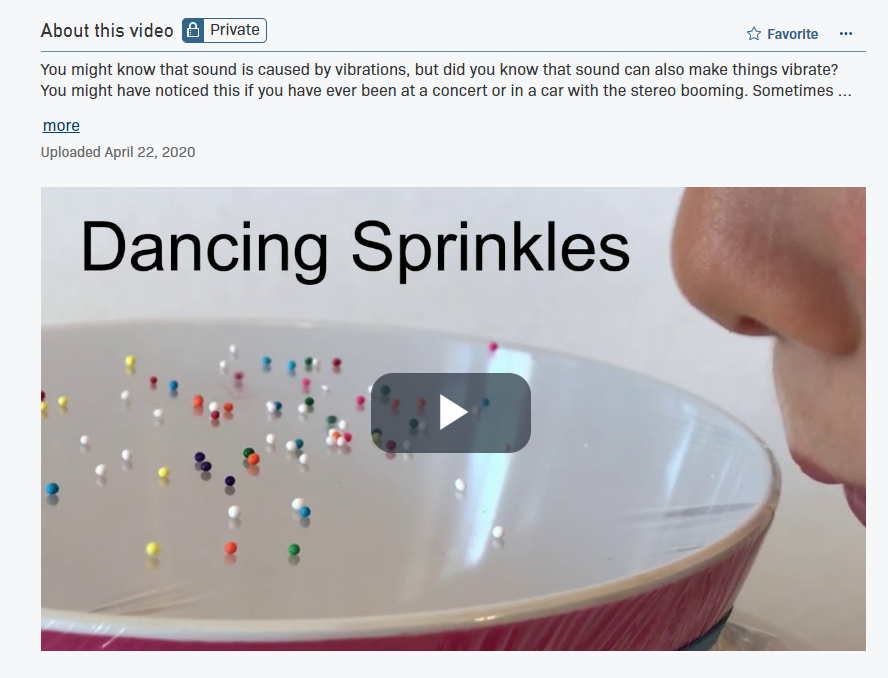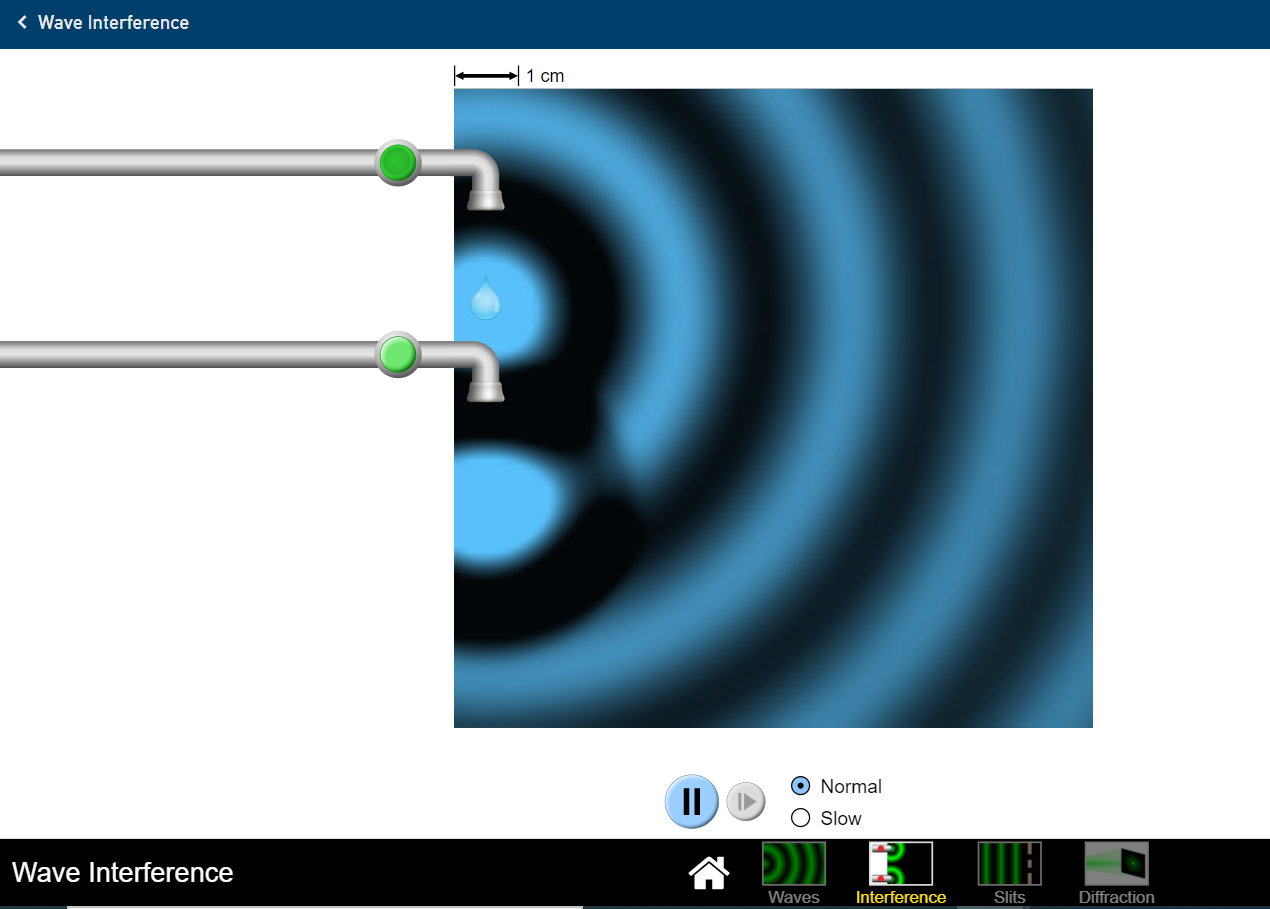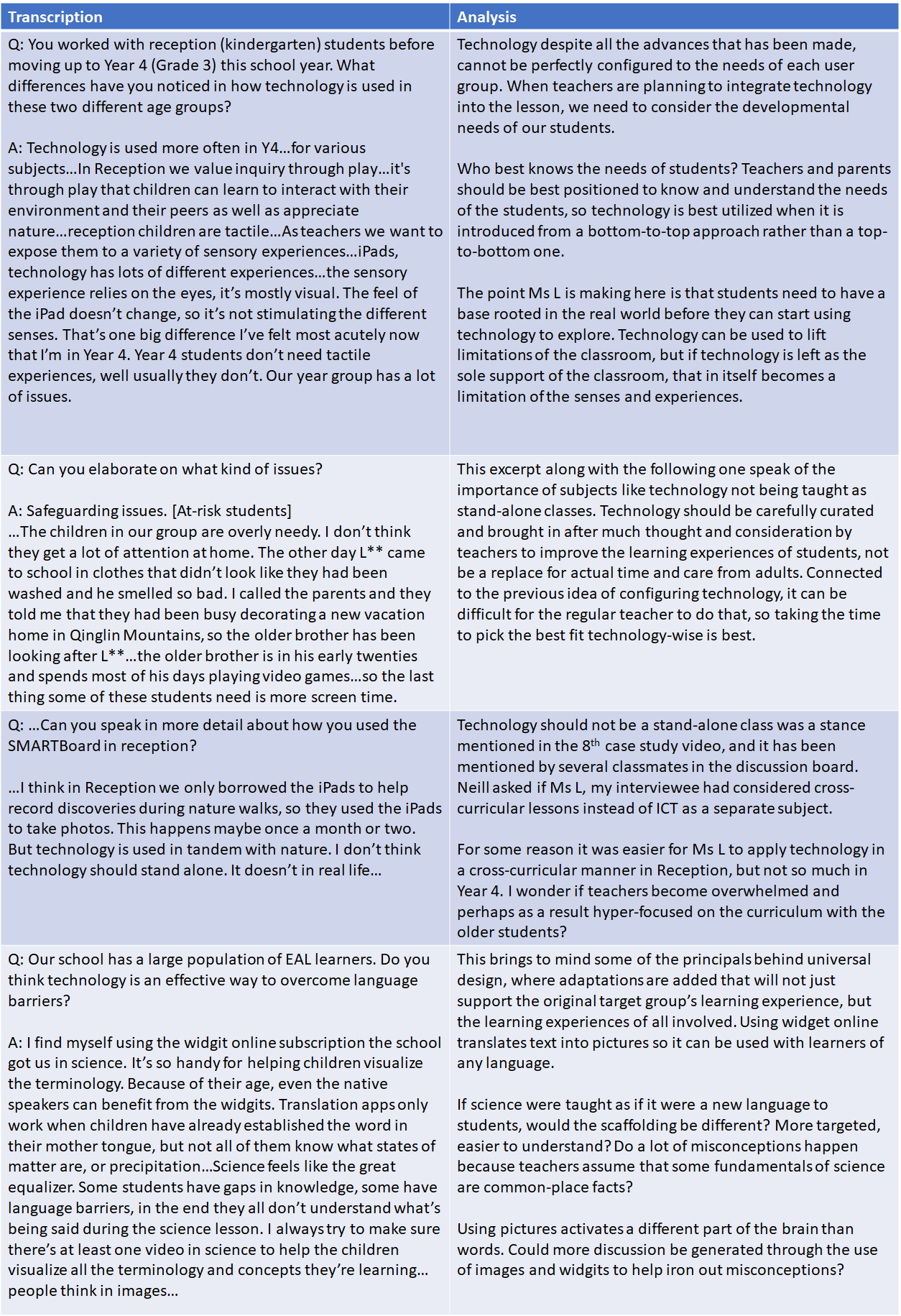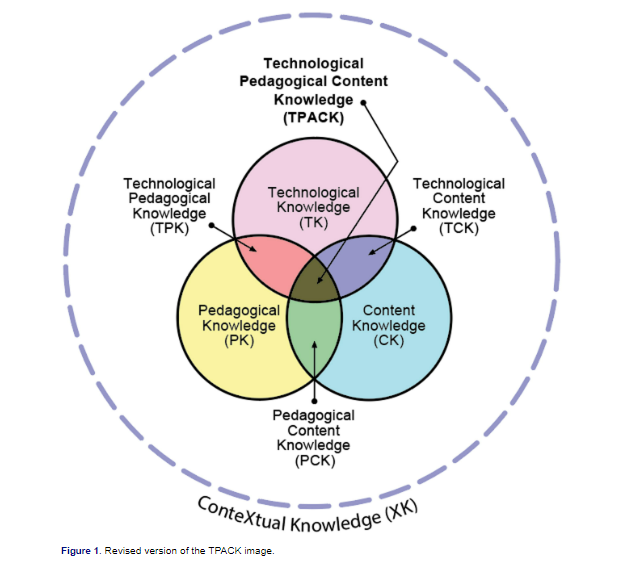Tag: ETEC 533
(Copy)T-Gem (Generate-Evaluate-Modify)
Snowflakes and States of Matter
Learning objectives:
- to be able to identify the state of matter of different elements found in nature
- to be able to explain whether or not heat is applied or removed to cause a change in phase
Challenge: Classifying different states of water in nature.
What happened: During the unit Land, Sea and Sky, my Grade 3s had a lesson about states of matter. Most of them remembered what they had learnt the previous year and were able to list the three states, but when we looked through different landscape pictures, they had trouble classifying snow. Is it a liquid? Or is it a solid? During the discussion students flipped back and forth between liquid and solid.
This uncertainty could stem from the visuals often used in videos and texts. The definition of solids created by these visuals are often narrow and similar to this depiction of neon atoms in solid state:
The simulation provided by PHET shows a broader definition of solids that could help with this misconception.
Simulation link: https://phet.colorado.edu/sims/html/states-of-matter/latest/states-of-matter_en.html
The below table is modeled after Khan’s (2007) Three Levels of Teaching Strategies table. I changed the column titles for main teaching methods to student activities to match the lesson plan format my school uses.
Learning for Use
- Using additional literature from the field of science education, what are several conceptual challenges students might have today with understanding Earth Science that LfU might support?
Nussbaum and Novak’s (1976) research discovered the following misconceptions about earth’s shape and gravity among elementary school students:
- while they can state that the earth is round, their understanding of round revealed that round could mean that the earth is a “‘circular island that people can sail around,’ or that the ball-shaped earth is a ‘planet in the sky, where astronauts go'” (Nussbaum & Novak, 1976, cited in Sneider & Ohadi, 1998, p. 266).
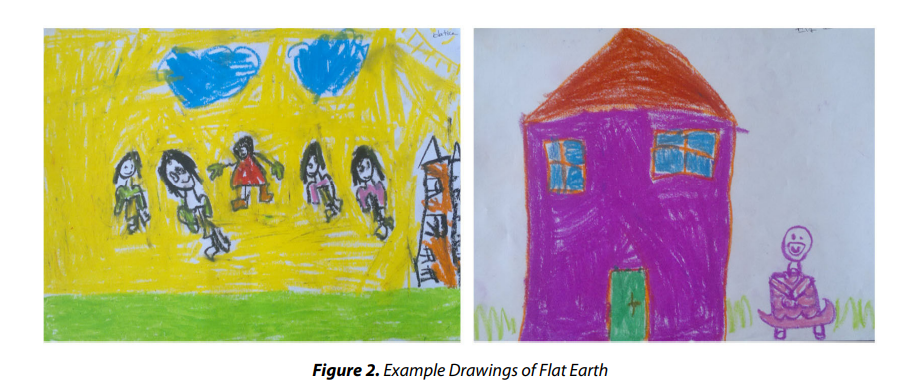
Note. Retrieved from “Is the earth flat or round? primary school children’s understandings of the planet earth: The case of turkish children” by S. Ozsoy, 2012, International Electronic Journal of Elementary Education, 4(2), 407-415. - Even among those students who understood round as their teachers intended, they did not understand the concept of gravity and explained that people did not fall from the southern end of the earth because people only lived on the “top” or the “flat part in the middle” of the earth (Nussbaum & Novak, 1976, cited in Sneider & Ohadi, 1998, p. 266).
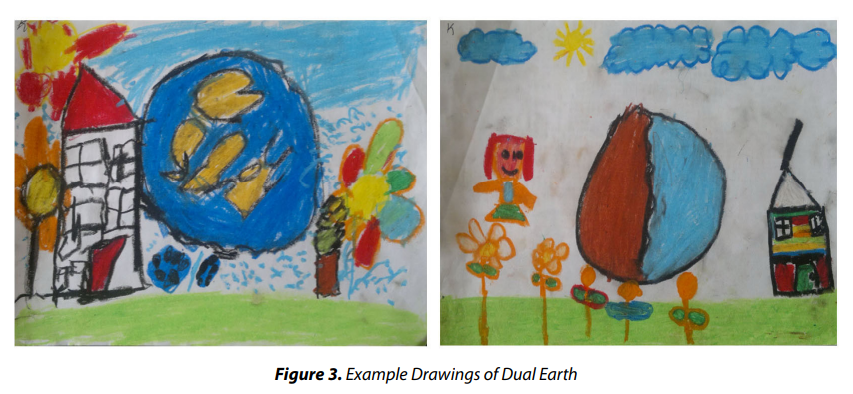
-
Note. Retrieved from “Is the earth flat or round? primary school children’s understandings of the planet earth: The case of turkish children” by S. Ozsoy, 2012, International Electronic Journal of Elementary Education, 4(2), 407-415.
Vosniadou and Brewer (1987) state these misconceptions occur due to traditional teaching methods often result in “weak” rather than the necessary “radical” restructuring of concepts (cited in Sneider & Ohadi, 1998, p. 267). LfU’s emphasis on “deep and robust” understanding (Edelson, 2001, p. 356) of science concepts would be beneficial to clearing these misconceptions.
Giving children goals, and presenting information gaps, such as: Why don’t penguins living in the South Pole fall off the earth? could be used to motivate children and challenge their current understanding of the earth’s shape and gravity. The multi-step processes and activities that the principles of LfU demand makes sure that learning does not end with students simply stating that the “earth is round.”
- Imagine how LfU principles might be applied to a topic you teach. Now switch out the My World technology. What other domain-specific (and non-domain specific) software might help you achieve these principles while teaching this topic?
A unit I will have to teach next school year is on sound. The key learning objectives the unit will cover are:
- to be able to explain how sounds are made by vibrations;
- to be able to explain the journey of these vibrations to the ear and then the brain;
- to know the relationship between objects like musical instruments and their pitch;
- to be able to explain the volume of sound in relation to vibration;
- to be able to conduct scientific investigations into sound using relevant variables
Principle 1: Modifying existing knowledge structures
Students’ basic knowledge of sound is that it is sensed with the ears. Subconsciously most of them probably know that sound can be felt, this simulation can be used to build upon their understanding of sound as part of the sense of hearing to expand to sense of touch as well.
Domain-specific software: https://www.labxchange.org/library/items/lb:LabXchange:4f11b1e3:lx_simulation:1
Principle 2: Knowledge building consists of conscious and subconscious goals
Now that students are conscious of sound’s sensory effect on touch, they can challenge themselves to explore other ways sound affects the other senses.
Domain-specific software: https://www.labxchange.org/library/items/lb:LabXchange:a90c14c8:lx_simulation:1
Principle 3: Learning should be built in a situation conducive to future knowledge construction and use
Observations from real life can be brought into the classroom and further examined with the use of simulations.
Domain-specific video: https://www.labxchange.org/library/pathway/lx-pathway:b1ab2716-6a2f-49a9-94e5-430f860cc75a/items/lx-pb:b1ab2716-6a2f-49
Domain-specific software: https://www.labxchange.org/library/pathway/lx-pathway:b1ab2716-6a2f-49a9-94e5-430f860cc75a/items/lx-pb:b1ab2716-6a2f-49a9-94e5-430f860cc75a:lx_simulation:d5dc9783
Principle 4: Knowledge needs to be formed so that it can be used before being applied.
Reflecting and sharing are ways for students to make their learning visual. Padlet and wakelet are platforms students can share and curate their learning through written text, images, links to videos and articles to create a community of learning where students move from passively inputting knowledge to actively taking part in constructing knowledge.
Non-domain specific software: Padlet and Wakelet
Food for Thought, the entry written in the Preformatted text is a copy of the discussion post. After this, you can find the references.
-
In what ways would you teach an LfU-based activity to explore a concept in math or science? Draw on LfU and My World scholarship to support your pedagogical directions. Given its social and cognitive affordances, extend the discussion by describing how the activity and roles of the teacher and students are aligned with LfU principles.
Learning for Use (LfU) model was created by Edelson to bridge the gap created by traditional science teaching practices based on knowledge acquisition and the demand placed on students in an inquiry-based learning model where knowledge is used to support inquiry skills (Edelson, 2001). Edelson (2001) found that traditional science classes promoted memorization and recitation, but a much deeper and firmer understanding of science concepts is necessary for students to engage in scientific inquiry. Edelson (2001) based the LfU on four principles:
-
Learning consists of building and modifying existing knowledge structures. -
Building knowledge is goal-oriented, instead of learning because it is necessary to complete the unit. -
The situation that learning construction happens determines whether learners can index and refer to their learning in the future.
-
Knowledge needs to be formed so that it can be used before being applied.
While I have not written about it, during these last few weeks on WISE, SKY and now LfU, I have been considering how to apply these to mathematics. Their use of interactive simulations and problems seems so much more engaging than worksheets! One reason I am hesitant to make changes to my math lessons is the lack of time. Every week ten of my Grade 3 class' lessons are with specialist teachers. I think I need to consider lessons from a cross-curricular angle to not only better accommodate the time constrictions, but to better fulfill Edelson's (2001) LfU principles, especially principle number 3. I think I could combine the measurement unit on money with the science unit on food and nutrition where the exit point is a food stall run by individual or pairs of students. The starting learning objectives for the money unit are to use bases of 10 and 100, but Chinese money isn't that helpful there (the hundredths place is not always filled) and many children are used to seeing adults use their phones to make purchases, so introducing British pounds and pence will happen in these circumstances. To create goals for students, I think I could have students compare different currencies. Although most of my students are of Chinese heritage, they all have foreign passports, so the possibility of travelling overseas is there. They could make a Venn diagram comparing the different notes and coins to motivate themselves to learn and use the British currency system. The other learning objectives for the unit are to add/subtract, give change and solve problems using four operations. The exit point could be used to motivate students to achieve these learning objectives and the profits from the food stalls can be donated to a charity of the student's choice, to give the students a goal and reason for the learning to happen. They could create a currency/token system for the food stall event. The exit point also "creates demand for knowledge to successfully achieve his or her goals within [this] context" (Edelson, 2001, p. 375). Reading Edelson's (2001) article, I realize that I often use technology to gather information, but I rarely use it to show information. Technology can be integrated by using excel to help students keep track of their sales and money earned. This could be a good opportunity to reinforce checking their calculations, something some of my students neglect in their rush to finish first. A graphing tool can be used so students can compare their profits. To build knowledge in a situation that can help students easily reference this knowledge in the future, websites like TopMarks have money games using notes and coins to help students familiarize themselves with British currency and practice using money in shop-like simulations. The fourth principle is a bit harder for me to visualize. I think using whole-part-part models and number lines could help students visualize their learning so they can apply it in real-world situations. Using fake money and simulation games can also help make this learning useable. The actual running of the food stalls can happen in two parts, the first part can be a soft opening, allowing students to have "direct" experience using money in a real-world context and a chance to receive "direct or indirect communication" (Edelson, 2001, p. 360) when they interact with customers. Having a soft opening will also give students time to refine their learning. I think the soft opening could create curiosity by "surprising" (Edelson, 2001, p. 376) with the knowledge gaps they have. I imagine there will be students who find calculating change easy because they have a strong understanding of place value as well as strong mental math skills, but they may only be familiar with calculating change through subtraction, but cashiers are often taught to count up when giving change, this might not make sense to students in explanation; however, it can make more sense when students have a chance to apply it in a busy situation. They can try out different methods to solve problems as they occur during the soft opening and after the soft opening they can use the knowledge they acquired to reflect on the experience and make changes to make the actual event smoother. The reflection portion of the refine stage gives students a chance to solidify their connections between knowledge and experience.
References
Edelson, D.C. (2001). Learning-for-use: A framework for the design of technology-supported inquiry activities. Journal of Research in Science Teaching,38(3), 355-385.
Ozsoy, S. (2012). Is the earth flat or round? primary school children’s understandings of the planet earth: The case of turkish children. International Electronic Journal of Elementary Education, 4(2), 407-415.
Sneider, C. I., & Ohadi, M. M. (1998). Unraveling students’ misconceptions about the earth’s shape and gravity. Science Education (Salem, Mass.), 82(2), 265-284. https://doi.org/10.1002/(SICI)1098-237X(199804)82:2<265::AID-SCE8>3.0.CO;2-C
Transcribed Interview and Analysis
Reflection:
One of the reasons I entered the MET programme was to learn more about how technology could be effectively used with lower primary and early years students, but I soon dropped that inquiry, there was not a lot of literature available in that area and I no longer teach that age group. My focus shifted to using technology effectively and differentiated learning, trying to meet the needs of a diverse group of learners. As I inquire into this situation, I have a clearer understanding of what it means to bring technology into education. I tend to use the words augment, enhance and transform in my discussions, but I use them without context. Each context is different, for early years it is about creating multi-sensory experiences and for science and math, it is about clearing misconceptions, which often involves helping students visualize concepts.
I don’t think good technology necessarily means it can be used with a vast range of users, but it should be able to generate discussion. Giving students clear-cut definitions and explanations is simple, but does not benefit the students. As seen in some of the earlier discussions, concepts in science and math are built upon as students move through the school system. Students need to be aware of this need to be flexible so they can adjust their understanding as they (and the world) make new discoveries. Misconceptions are connected to the words we use, so for my inquiry, I am shifting to examine how technology can be used to support understanding of science terms, so this is not limited to EAL learners, but to all students.
(Copy) Unpacking Assumptions
Lesson 2 Activity 1: Unpacking Assumptions, “What is a good use of technology in math and science classrooms?”, as a possible prompt. The goal is to begin to identify and frame an issue that stands out for you stemming from your observation of the video case materials. Ask yourselves and each other:
-
- What are the underlying issues and why are they issues?
- What further questions does the video raise for you?
- How would you explore this issue further?
I’m definitely late to this party. It feels like whenever I think I’ve gotten the hang of this course, I miss a deadline and quite obviously I don’t. 🙁
In Case Study 5, I was taken with how art was integrated into science. I feel there needs to be more STEAM than STEM classes, especially with globalization, children from different backgrounds are forming the classrooms and sometimes art is the best way for some of them to express their learning. By adding art, children can learn without even realizing it. Just as the teacher in Case Study 8 mentioned, technology should not be a stand alone subject, and art shouldn’t be either. Art should be functional and appealing, and isn’t that what technology is striving for too? Functional and appealing?
Personally I ran a stop-motion-animation afterschool club at my school this year, so I was keen to look into Case Study 8’s slowmation. I have mixed opinions about that case study. While I appreciate the dedication of the pre-service teachers in making a slowmation to show their classes, I think it would have been more practical to use a powerpoint to present their clipart or to find an existing life cycle video online even if the life cycle is not a complete match for the one in the textbook. Maybe if I try making a slowmation for my classes I would reach the same level of appreciation of slowmations in the classroom, but for my situation I feel it would be creating unnecessary work for myself to ignore the media already available on the topic. Especially since those pre-service teachers working on Science Probe 4 did not mention having their classes create their own slowmation. If classes are going to create a slowmation, then the teacher should create one to show as an example and to have enough working knowledge to assist the students. I thought the most beneficial way for me to use slowmations would be to have my students research and present a life cycle as a slowmation, as the first video showed.
I like the idea of slowmation, but I feel there needs to be more flexibility in the lesson so student involvement remains high no matter the grade-level. Having children research and present a life cycle is probably most suitable for Grades 3 and up. I thought the slowmation of the salmon life cycle was beneficial to the students because it showed them the importance of teamwork, but how to connect the process to science better? If I were to introduce lower primary students to slowmation, I think it would be through a year-long project on seasons. They could take nature walks, be tasked with photographing certain elements such as leaves and insects and at the end of the school year they would go through the photos and organize them on a storyboard so they show the progression of change or life cycle of different elements in nature. Then these photos could be used to create a slowmation. I think this idea could work because it builds on the students’ previous knowledge. Perhaps a rule of thumb could be to introduce new things gradually. So if students use a different mode to present their learning, they’ll present the learning of a concept that is already somewhat familiar to them so they can turn more attention to the new mode.
How could I further investigate this issue of technology use in the lower primary classes? I think I could observe some lower primary students during their ICT time. I could also have my class visit one of the kindergarten or Grade 1 classes to teach them how to use the iPad to do something simple, but there’s not a lot of time left in the school year. If I want to find something before the school year ends, it’d have to be through the experiments and observations of others, so journal articles.
An issue that could be explored in the 5th case study would be how art is regularly integrated into EAL and science classrooms. For example, my own classes use pictures sometimes to take notes, but what else can be done? And does it work with everyone? Not everyone likes to art. I’d like to see what research has been done on art in the EAL learners’ science classroom.
Module A Lesson 2 – What are the characteristics of effective technology in the math and science classrooms?
Transformation through Differentiation
How could or should we use technology in math and science learning environments and how might technology be used to support or enhance learning?
The easiest way we could use technology in math and science is as a replacement for what is already happening in the classrooms. For example, instead of using textbooks, use AR or videos. Instead of live dissections, do it virtually instead.
Financial hurdles could also be overcome through technology. As stated earlier, virtual dissections, and trips to the museum or labs could be done virtually. Guest lecturers/experts could be brought in virtually or through educational video material such as Planet of Earth or National Geographic.
But how should we use technology in math and science learning environments? Lots of support is needed to enhance educators’ teaching and attitude towards technology in the classroom. Everyone needs to be onboard, admin and school boards included. If school boards approve spending on technology but the teachers aren’t on board, technology use will be ineffective and/or sporadic. I think effective technology use has to happen from the bottom up. Technology can replace traditional learning methods, augment them, or transform them. Effective technology use in learning environments happens when there is a transformation in learning. When I think of transformation, I imagine students reflecting on their learning and applying to contexts outside of the classroom and differentiation. Differentiation could be a way to transform the learning experiences of students. How often have I heard people say they “can’t do math” or “don’t get chem”? Perhaps differentiation could happen best in a flipped learning environment. Content could be completed at the individual’s own pace and teachers could monitor their progress and create different groups to work with each week. If students could learn to be comfortable with their own learning journey and be comfortable asking for help, they could also ask their classmates for help when the teacher is busy working with another group.
ETEC 533 Inquiry E-folio
This post will contain my inquiry e-folio entries for ETEC 533. I am a generalist teaching Year 4 (Grade 3) students at an international school. George Bernard Shaw, the great English writer once said, “He who can, does. He who cannot, teaches” (cited in Shulman, 1986, p. 4). I see this as a strength because it means that a teacher understands the misconceptions their students have because they themselves have had to overcome these misconceptions so they have a deeper understanding of the concepts and they can use their own learning experiences to predict where their students may struggle.
Chunk 1
But can a solid science and maths curriculum be built solely on a teacher’s own learning experiences? Shulman (1986) addresses this with the following proposal:
“How might we think about the knowledge that grows in the minds of teachers, with special emphasis on content? I suggest we distinguish among three categories of content knowledge: (a) subject matter content knowledge, (b) pedagogical content knowledge, and (c) curricular knowledge” (p. 9).
This is my first time distinguishing between the different types of knowledge I have. When I apply for teaching positions, my curricular knowledge is often prioritized first, it is what lets me into the door for a job interview. Displaying my pedagogical content knowledge happens within the interview, but the focus is usually on the presentation of content knowledge rather “than reorganizing the understanding of learners” (Shulman, 1986, p. 10). How am I arranging and developing my own knowledge to strengthen and adjust my students’ science and mathematics foundations?
Chunk 2
How can I make my students’ learning visible for planning and assessment purposes? Mishra (2019) states that contextual knowledge is necessary for a teacher to successfully integrate technology into the classroom. What is contextual knowledge?
Mishra (2019) explains that contextual knowledge “highlights the organizational and situational constraints that teachers work within. The success of their efforts depends not as much on their knowledge of T, P, C and its overlaps, but rather on their knowledge of the context. This allows us to go beyond seeing teachers as designers of curriculum within their classrooms but rather as intrapreneurs—knowing how their organization functions, and how levers of power and influence can effect sustainable change. This is XK—Contextual Knowledge (p. 2)”.
From Mishra, P. (2019). Considering contextual knowledge: The TPACK diagram gets an upgrade. Journal of Digital Learning in Teacher Education, 35(2), 76-78.
Reading Mishra’s definition reminds me of the phrase, “keep it real” which was often stated by my co-hort during my time as a BEd student. But everyone’s context is different, and my own context will vary from school year to school year since I do not usually stay at a school for more than three years. I agree with Mishra that the teachers who understand contextual knowledge are best able to swim with the current to reach knowledge goals, but this is insider knowledge that can only be accessed if my TPACK is solid. Schools won’t hire me if I don’t have TPACK, so my e-folio will look for the areas TPACK overlap. If I can find how they work together, I can learn to make TPACK function within whatever context I am in.
Click on the links to access different e-folio posts:
(Copy) Definition of Technology
(Copy) Embodied Learning Discussion Post
(Copy) Too real for the classroom? – Role playing in mathematics and science
(Copy) The Steroids of the Classroom: VFTs and AR
(Copy) Colouring in the Spaces of Diffusion: Modified T-GEM Cycle
References
Mishra, P. (2019). Considering contextual knowledge: The TPACK diagram gets an upgrade. Journal of Digital Learning in Teacher Education, 35(2), 76-78.
Shulman, L.S. (1986). Those who understand: Knowledge growth in teaching. Educational Researcher, 15(2), 4-14.
